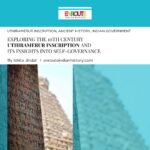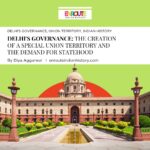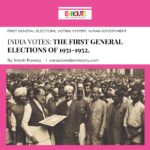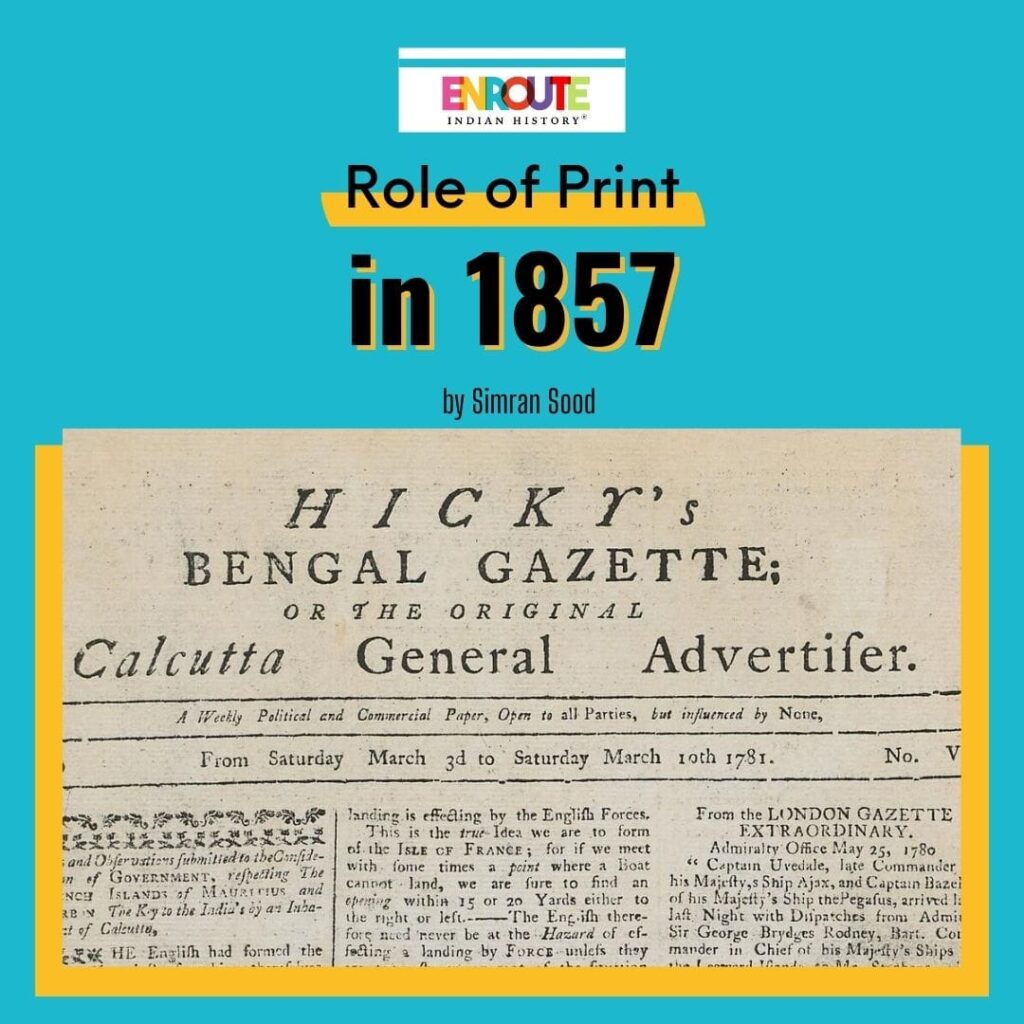
Article Written By EIH Researcher And Writer
Simran Sood
The role of print culture in the events of 1857, also known as the Indian Rebellion or the First War of Independence, holds significant historical importance. Print media, including newspapers, pamphlets, and literary works, played a crucial role in shaping public opinion, disseminating information, and mobilizing the masses during this critical period in India’s history. The emergence of print culture in the 19th century provided a platform for diverse voices and ideas, ultimately influencing the course of the rebellion and its aftermath. Understanding the role of print culture in 1857 allows us to appreciate the power of media in shaping political movements and revolutions.
‘Bengal Gazette’, started in 1780 in Calcutta, is the first press ever introduced in Indian society under J.A. Hickey, who was deported for his editorship since he tried to write against his government. Followed by this, there was the creation of journals like ‘Morning Post’, ‘Indian Gazette’, ‘Asiatic Mirror’, ‘The Indian World’, ‘Bengal Harkaru’, ‘Samachar Darpan’, etc. From the beginning, East India Company looked at these newspapers with hostility and suspicion. In 55 years since their inception, the editors and the people associated with the newspapers suffered in the name of “liberty of speech and the freedom of the press”. Their goal was to extend the “bonds of human freedom”. The efforts of the newspaper editors were successful when Charles Metcalfe passed the Press Act of 1835. He is called the “liberator” as he understood the need for the press. Hence, till 1857, the Indian media was liberated as it was “a blessing to any country” in Metcalfe’s views (Srivastava 318).
Indians utilised the platform of the press to support their rights and freedom, oppose the activities of the missionary, throw backlash against the critique by the British press on Indian religious activities, and design and organise public opinion which resulted in the revolt of 1857. The British believed that their previous procedure of allowing licenses for the newspapers was more effective in keeping the Indian press in check (318).
The Act passed by Metcalfe threw all of its weight against the government as it was its role to denounce anyone breaching the Act. However, the Britsh did not veto it for a long time and its complete and residual effects by realised by everyone after the Revolt of 1857. The Indian Press successfully created ripples in the form of intellectual revolutions, which eventually gave way to the revolt. English and other language papers came together to review, criticise, and expose the British Party and its governmental acts. They were very candid and condemnatory. They would censure the East India Company’s main officers and its administration. The vernacular papers reminded Indians of their obligation towards their motherland (Srivastava 319).
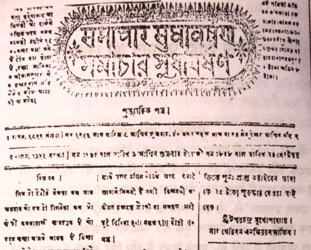
Native Newspaper of 1857 (Samachar Sudha Varshan, May 1855)
There was a variety of newspapers in British India:
- Press that was supported by the East India Company, which included English and vernacular press.
- Introduced by the well-educated Indian elite, there were newspapers in Bengali, Persian, English and other languages. People like Hari Dutt and Raja Ram Mohan Rai founded them. The newspapers were reformist and nationalist and different from North Indian ones in their execution. The primary focus was the development of people and society.
- Few rulers and nawabs supported some Urdu papers for their purposes or to be in the graces of the newspaper owners.
- Persian and Urdu newspapers were founded in war-ridden areas such as Delhi, Agra, Lucknow and Banaras (Naghmana and Baloch 29).
Some of the influential newspapers of that time were:
Bangadarshan. Genesis of Bengali Nationalism, it was founded in 1872 by Bamkim Chandra Chatterjee. The newspaper published Vedic literature (Hussain 231).
Hawking Publications. At the price of half an anna, they educated the public on campaigns from Sind, Afghanistan and Punjab. It contained ideas about theology and rules, and rituals. They also contained patriotic passages and ideologies about racial discrimination and appealed to religious sentiments (Srivastava 320).
Indian newspapers profoundly influenced the middle classes and the common folk. The rulers of Indian states had subscriptions to the British press. They contained articles on Oriental despotism, how the State’s forces were organised, etc. These articles were translated by Indian newspapers and published to create agitation in the public’s minds as they also criticised the rulers (319).
During the uprising of 1857, the English East India Company repealed the Press Act in June 1857 and put the Gagging Act in its lieu. Repealing the Act created bitterness, mistrust, and breakage in public confidence. The bitter nature of the people came with the package since their fundamental rights were being questioned. Indian press would warn the East India Company for their “red-tapism, delaying tactics and lack of foresight”. In the absence of the press, the government did not have access to any medium that could counter the spreading of rumours, and as a result, people were saying and imagining anything they wanted against the company. The people believed East India Company was supporting the suppression of truth, allowing them to attribute dishonourable qualities to the company (Srivastava 321).
Newspapers were one of many ways of transmitting news. There were other means too. Wandering religious ascetics spread the news to every corner of the country. Newsletters were hidden behind bills. Foot and camel messengers, in addition to security guards and priests, would carry the news with them. These harmless agencies were appointed by freedom fighters “for the dissemination of ideas against the foreign race and rule” (Srivastava 321).
Today, as we reflect on this pivotal period in history, we recognize the immense influence of print culture in shaping political discourse, inspiring collective action, and preserving the narratives of a nation’s journey towards freedom. The role of print culture in the events of 1857 serves as a testament to the transformative power of ideas and information. The emergence of newspapers, pamphlets, and literary works during this time provided a platform for expression, unity, and resistance. Through the dissemination of revolutionary thoughts and nationalist sentiments, print media played a significant role in mobilizing the masses and fueling the flames of rebellion. The legacy of print culture in 1857 extends beyond the immediate context, leaving a lasting impact on India’s struggle for independence and the subsequent development of media and communication.
References
Hussain, Nazakat. “Role of Vernacular Press During British Rule in India.” International Education and Research Journal3: 231-33.
Srivastava, K. L. “The Contribution Of The Press To Development Of National Ideas And Dissatisfaction Against The British Rule Especially In Central India—Malwa During The Revolt Of 1857.” Proceedings of the Indian History Congress, vol. 17, 1954, pp. 318–21. JSTOR, http://www.jstor.org/stable/45436406. Accessed 13 May 2023.
Tahir, Seemi Naghmana, and Munir Ahmed Baloch. “War of Independence 1857 and the Role of Urdu and Persian Newspapers.” Pakistan Journal of History and Culture 30.1 (2009): 25-42.


